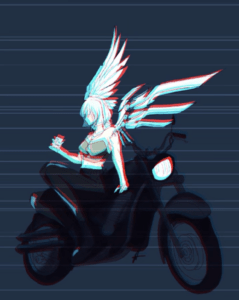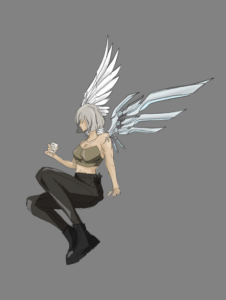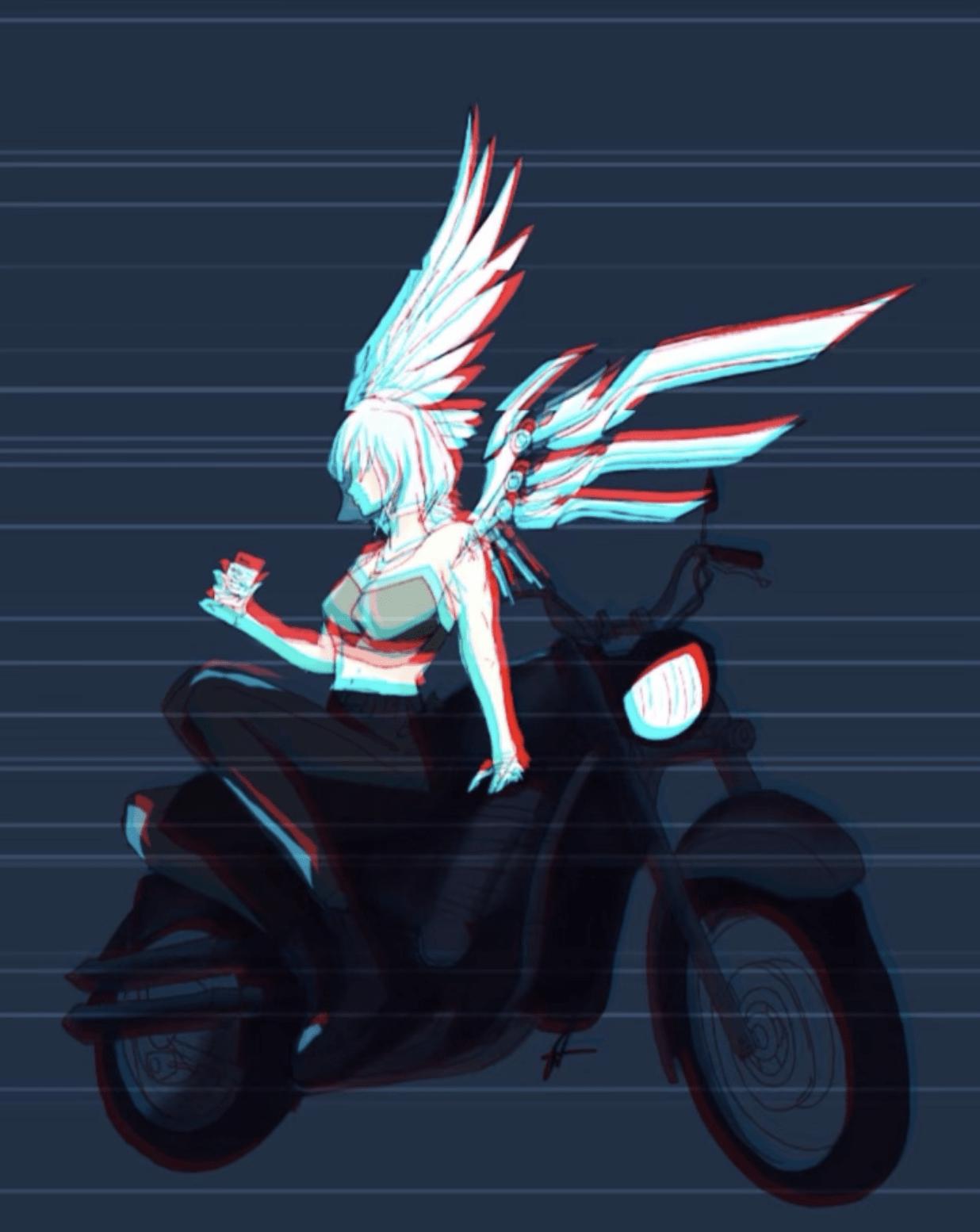

HOMEBOUND
cover art: kana, the playable character, drawn on procreate by myself 🙂
https://notdisgraced.itch.io/home
Premise:
I’ve always been abit of a fanatic when it comes to science fiction stories. I loved the original Blade Runner and other stories of its genre, like the book it was originally based on (Do Androids Dream of Electric Sheep), Neuromancer, etc – hallmarks of the origin of grunge, cyberpunk, dystopia, nearly half a century ago. And newer media too, movies and stories like Ex-Machina, video games like CyberPunk 2077 and its adaptation, and the likes. I think it’s also a common refrain, especially in recent years/decades, of the fascination with AI and the fear of some sort of AI takeover, balanced with the increasingly pertinent questions of AI ethics and the meanings of humanity and morality when it comes to the intersection between humanity and technology. I thought it would feed well into a dystopian concept where the world has been ravaged by climate change and humanity is pushed to use technology to survive and forcibly adapt, and those with more tech implanted in their bodies (think Shepard being rebuilt into essentially a cyborg by Cerberus in the Mass Effect games) in order to reduce reliance on basic human necessities. Those with more machines in them are better equipped to survive and are thereby “superior.” But, of course, this comes at the cost of control and inequality in society between different factions. From there, the ideas expanded. It was natural to want to construct some rebellion where the subjugated “good guys” overthrow the corrupt rulers who maintain all of the power, and the protagonist, who the player plays as, would be involved in that effort. I decided to incorporate the isekai trope, where the main character is transported to an alternate universe with no prior recollections or memories and has to navigate and learn their way through and learn their piece in the puzzle. Add in some hopefully intriguing backstory and a potential love interest and toss in a betrayal as a moment of crisis before everything ends with a hopeful ending – that was the vision that I’d gone for.
The term AIngel is honestly something that I’m proud of. I’m not a spiritual person particularly myself but AIngel just fit so well as a moniker for angel, and I thought it symbolized the deeper meaning of humanity trying to achieve perfection in any way it could by transcending humanity through technology, while tying in a hint of god complex about arrogance and superiority. This ties in with the idea of rebirth, as part-machine, and “Creation.” I thought it was a clever and fitting play on words.
I wasn’t sure how to write a full happily ever after without really completely implementing all of the changes that society would have to undergo to become non-dysfunctional, so I settled for a return to the real world, or home. It’s intentionally ambiguous whether or not the protagonist passes away at the end. I was inspired to have themes of home throughout just because it’s something I’ve always thought was significant personally. Where is home? (I have never truly felt home in any place I have ever lived and I feel like I’m constantly searching). I think sometimes, hopeful endings are more appropriate than happy ones. And I thought this was such a case.
Feedback and Iteration:
Most of the feedback and iteration was oriented around how much story vs player autonomy balance I wanted to incorporate. I think that from the start, I wanted the story to go a certain way regardless what the character’s intermediate actions were. When I played through Creatures Such as We, I felt that was the sentiment created by both the literal game, where someone falls into the crater, as well as the game within the game, where the ending is always a betrayal by Elegy regardless what the player does differently. It was meant to have more emphasis on the fiction, with interactivity being the engagement of the player in the story rather than the player actually playing an involved game. This was also why I chose to use Twine instead of a parser fiction, which I feel like involved much more deduction and investment. This was sort of a middle ground between both, where many of the actions to click to the next step would’ve been an action that would be directly typed out by the player in a parser friction. It takes away the annoyance and friction of trying to figure out exactly which action and words need to be prompted and carries the player right through the story in a straightforward way.
The main takeaways and actionable elements from feedback I incorporated were including more player choices throughout for better engagement, as well as changing formatting and breaking up walls of text into more digestible pages. Feedback that I received from the game was that the pacing of the story was fine – I had initially worried about it being too exposition-heavy, and that all of the playtesters understood the “dystopia” and conflicts within the story. I recieved good feedback about the element of a “romantic interest/love story” woven into the story, and I was affirmed that all of the descriptions that I had made it seem like a real story. Some smaller changes that I made were more dialogue and interaction as a means for describing the status quo and informing the player as well as the character themselves, for a more natural unfolding and unraveling rather than just explicit narration.
Reflection:
I’m not much of a writer, honestly. I also struggle significantly with writing and creating fiction – I just don’t think I’m a particularly creative and unique and original person and writer (maybe it’s fear. maybe it was stifled long ago. who knows). That was the biggest challenge for me – coming up with a story. I thought the technique that we read and learned about, the snowflake method, or starting from one main premise and expanding on a few try/fail conflicts throughout the plot was useful. Everything was written pretty linearly – I wrote one element of it at a time, one mini conflict/resolution at a time. I think if I were to do things differently, I would’ve included more dialogue and character-driven world exploration, instead of just having moments of explanation built into the game through certain character interactions. I would also incorporate Twine formatting into my drafting. I had the story written out in a Google Doc before I started manually splitting and editing it into Twine – I should’ve done all the bracketing formats for links between pages in the game all within Google over text instead of doing it manually with every Twine panel. I think I was also inspired by seeing how some other people had set up and written their Twine games – it was more clickthrough on certain actions – not every panel had to have a choice associated with it, which was refreshing. It kind of became a clickthrough or walkthrough story in some other peoples’ games that I played, which was kind of the vibe I tried to go for throughout parts of mine. Also, I personally feel like it’s a little clunky if every minute detail or action has to be correlated and driven by a prompt – it feels filler and throws off the flow of the game, so I tried to make it as frictionless as possible for leading throughout the story.
I think I could’ve made the playable character more customizable and include more autonomy on the player’s end about their own identity within the story. I wasn’t sure how to balance creative liberties with an established backstory.
Another difficult element was testing. It was alright to test out certain plot points, but many people just don’t have enough time to play through the entire game from start to finish, which is really the only authentic gameplay experience, for the intents of pacing and overall story design and game experience. I was glad we had dedicated time in class set for people to play through the entire storyline to receive feedback about holistic elements such as pacing, overall story, learning, etc.




An important value in this story is finding your identity. You start this game without knowing who or what you are. I enjoyed how different choices could reveal different parts of your identity faster and influence how you would help in the rebellion. These choices to have branches in the narrative make the satisfaction of learning who you are even more apparent in the game.
Another value in this game is deception. At certain points, you are deceived through the storytelling of other characters to believe one thing, but experience another. These plot twist help build the deceptive future of this dystopian world and create more interesting ramifications from your choices.
I thought that the game really enticed me to care about the topic, due to the fact that the storytelling was so immersive and detailed. The level of detail helped me feel me very invested in the topic of the game.
I think that the game’s use of medium really fit the story. I thought that the branching choices worked really well with the dystopian alternatives you face. I could also imagine this game being a digital game where you are moving around rooms to uncover new information.
I loved the choices of being able to explore rooms (left, right, etc) because they made me feel like I was really exploring a space. That mirrored the movements I would actually make in real life and made the discovery of new information maze-like.
The world building in this game was very thorough. I found myself embedded in the descriptions of the characters and the mystery of my identity spurred me to further explore the world.
One thing to improve is the length of the text you read. I almost got lost reading some of the pages because they felt very long. I think shorter passages per page could be easier for the reader to digest between the different sections of the story. I loved the drawing that you did and wonder how images can be incorporated into the project to create an even more immersive world.
When I started playing Homebound, the first thing that I noticed was how everything was in lowercase, a deliberate choice that pulled me into the game and made me curious about the world. From the starting scene, it felt that each choice had consequences that were long lasting, starting from exploring the fog— posed as something seemingly dangerous because of either an overactive imagination of the character or something more.
The writing style of the IF is very descriptive and full of imagery and foreshadowing and mystery which contributes to a sense wonder. The game is very playful and cohesive due to well-written passages and slowly discovering more as the game went on. I was entice to play, and after writing this, want to explore even more of the options and narrative!
The medium of IF is also honored because choices are broken down and passages going down one path are broken up as to not overwhelm the reader and maintain attention. Although some of the passages are long, a decent amount of them are broken down as to be more digestible There are a lot of choices and each one feels like it contributes to the narrative in some way; as a narrative adventure, the medium feels perfect. As a side note I laso thought the idea of AIngels was super creative and the art cool and evocative.
In terms of caring about the topic, I think that the curiosity inspired by watching the narrative play gives one plenty to think about as that curiosity is resolved or fed. As you discover that the main character isn’t just a human, but rather an AIngel and see the dynamics of how other people subsequently treat her and the choices to make, the implications for society, it serves as a thought experiment applicable to the world we live in. I thought that here, values were implemented very well and verified in an intentional way diffused by virtue of the narrative.
Something that I thought was awesome was how the premise, medium and choices came together as mechanics to form a cool dynamic; one thing to improve upon is to make the choices truly consequential— having long impacts later on in the story rather just than short-term changes. I backed away a few times and came back only to discover the same choices, so my decisions (in retrospect) felt somewhat inconsequential, although this changed part of the narrative which was nice to experience.
Homebound
1. This story explores the value of agency and self-actualisation, pursuit of the identity. It is an exploration into the theme of what really makes one oneself, well situated in a dystopian world. It was thought-provoking and very fantastical, and I had a lot of fun reading it.
2. I think just by reading the story it might not have been as clear in terms of social goal / impact as the story was progressing. However, I think it did a great job at the end, because I thought it was really thoughtful and well written. In terms of the divergence, I didn’t think it was very diverging based on your choices. However, I don’t believe doing so is always so necessary.
3. The thing that I appreciated the most was that there was such a world to this. I could really see that the author had her own world by reading this story. I think I could definitely see how immersive and enjoyable the writing process would have been, and it is always a delight to explore a creation the author was passionate to create.
4. More confidence in the documentation! You are such a writer and I really enjoyed this story! More substantively, I think sometimes the text is a bit too much? Cut them into half and shorter paragraphs.